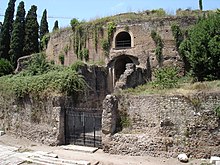Mausoleum of Augustus
 |
|
| Location | Campus Martius |
|---|---|
| Built in | 28 BC |
| Built by/for | Augustus |
| Type of structure | Mausoleum |
| Related | List of ancient monuments in Rome |
The Mausoleum of Augustus (Italian: Mausoleo di Augusto) is a large tomb built by the Roman Emperor Augustus in 28 BC on the Campus Martius in Rome, Italy. The mausoleum is located on the Piazza Augusto Imperatore, near the corner with Via di Ripetta as it runs along the Tiber. The grounds cover an area equivalent to a few city blocks, and nestle between the church of San Carlo al Corso and the Museum of the Ara Pacis. The interior of the mausoleum is not open to tourists.
The mausoleum was one of the first projects initiated by Augustus in the City of Rome following his victory at the Battle of Actium in 31 BC. The mausoleum was circular in plan, consisting of several concentric rings of earth and brick, planted with cypresses on top of the building and capped (possibly, as reconstructions are unsure at best) by a conical roof and a statue of Augustus. Vaults held up the roof and opened up the burial spaces below. Twin pink granite obelisks flanked the arched entryway; these have been removed; one now stands at the Piazza dell'Esquilino (on the northwest side of the Basilica of Santa Maria Maggiore) and the other at the Quirinal fountain. The completed mausoleum measured 90 m (295 ft) in diameter by 42 m (137 ft) in height.
A corridor ran from the entryway into the heart of the mausoleum, where there was a chamber with three niches to hold the golden urns enshrining the ashes of the Imperial Family.
The traditional story is that in 410, during the sack of Rome by Alaric, the pillaging Visigoths rifled the vaults, stole the urns and scattered the ashes, without damaging the structure of the building (Rodolfo Lanciani).LacusCurtius claims however that "The story of its plundering by Alaric in 410 has no historical foundation, and we know nothing of its destruction". In the Middle Ages the tumulus was fortified as a castle— as was the mausoleum of Hadrian, which was turned into the Castel Sant'Angelo— and occupied by the Colonna family. After the disastrous defeat of the Commune of Rome at the hands of the Count of Tusculum in 1167, the Colonna were disgraced and banished, and their fortification in the Campo was dismantled. Thus it became a ruin.
...
Wikipedia

